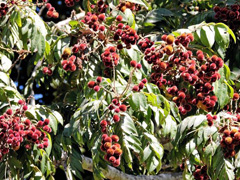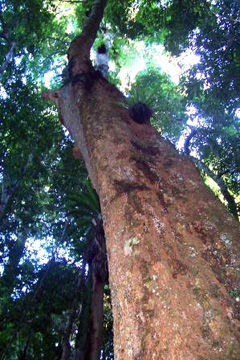 |
|
https://edibleplants.org/ |
 |
| https://edibleplants.org/ |
Translate this page:
Summary
Dysoxylum fraserianum or commonly known as Rosewood or Australian Rose Mahogany is a large tree native to New South Wales and Queensland, Australia. It can grow up to 57 m in height with trunk diameter of 3.5 m. It is typically long-lived, slow-growing, and shade tolerant. The leaves are dark green with 4-12 leaflets. The canopy is round and dense. Rosewood is known for its fragrant and attractive timber commonly used for high-grade cabinet work, furniture, and wood engraving among others.
Physical Characteristics

 Dysoxylum fraserianum is an evergreen Tree growing to 30 m (98ft) by 30 m (98ft) at a slow rate.
Dysoxylum fraserianum is an evergreen Tree growing to 30 m (98ft) by 30 m (98ft) at a slow rate.
See above for USDA hardiness. It is hardy to UK zone 10.
Suitable for: light (sandy), medium (loamy) and heavy (clay) soils and prefers well-drained soil. Suitable pH: mildly acid, neutral and basic (mildly alkaline) soils and can grow in saline soils.
It cannot grow in the shade. It prefers moist soil.
UK Hardiness Map
US Hardiness Map
Synonyms
Alliaria fraseriana Kuntze Alliaria lessertiana Kuntze Alliaria pubescens Kuntze Cambania fraseriana
Plant Habitats
Edible Uses
References More on Edible Uses
Medicinal Uses
Plants For A Future can not take any responsibility for any adverse effects from the use of plants. Always seek advice from a professional before using a plant medicinally.
None known
References More on Medicinal Uses
The Bookshop: Edible Plant Books
Our Latest books on Perennial Plants For Food Forests and Permaculture Gardens in paperback or digital formats.

Edible Tropical Plants
Food Forest Plants for Hotter Conditions: 250+ Plants For Tropical Food Forests & Permaculture Gardens.
More

Edible Temperate Plants
Plants for Your Food Forest: 500 Plants for Temperate Food Forests & Permaculture Gardens.
More

More Books
PFAF have eight books available in paperback and digital formats. Browse the shop for more information.
Shop Now
Other Uses
Furniture Wood
Other Uses: The red wood is durable and resistent to termites. It is very easy to work, planing especially well and producing an excellent finish. An attractive wood with a good figure, when freshly cut it has a fragrant odour of roses. Resembling mahogany, it is suitable for a great number of purposes including high-grade cabinet work, furniture, wood engraving, turnery, interior finish and wine casks[ 601 , 694 , 719 ].
Special Uses
References More on Other Uses
Cultivation details
A tree mainly of the sub-tropical zone in eastern Australia, occasionally found further north in the tropical rain forest. Established plants can tolerate some frosts[ 694 ]. Succeeds in full sun once established, but probably requires some shade when smaller. Grows best on richer soils and requires a well-drained soil[ 694 ]. Trees are frustratingly slow-growing when young, but can speed up somewhat and become moderately fast-growing after a few years[ 694 ]. We have no specific information for this species, but most members of the genus are dioecious, in which case both male and female forms need to be grown if fruit and seed are required[ 451 ].
References Carbon Farming Information and Carbon Sequestration Information
Temperature Converter
Type a value in the Celsius field to convert the value to Fahrenheit:
Fahrenheit:
The PFAF Bookshop
Plants For A Future have a number of books available in paperback and digital form. Book titles include Edible Plants, Edible Perennials, Edible Trees,Edible Shrubs, Woodland Gardening, and Temperate Food Forest Plants. Our new book is Food Forest Plants For Hotter Conditions (Tropical and Sub-Tropical).
Shop Now
Plant Propagation
Seed - sown fresh it can germinate within one month[ 694 ].
Other Names
If available other names are mentioned here
Australian rosewood, rose-mahogany, rosewood, turnipwood.
Native Range
AUSTRALASIA: Australia (New South Wales (east), Queensland)
Weed Potential
Right plant wrong place. We are currently updating this section.
Please note that a plant may be invasive in one area but may not in your area so it's worth checking.
Conservation Status
IUCN Red List of Threatened Plants Status : This taxon has not yet been assessed.

Growth: S = slow M = medium F = fast. Soil: L = light (sandy) M = medium H = heavy (clay). pH: A = acid N = neutral B = basic (alkaline). Shade: F = full shade S = semi-shade N = no shade. Moisture: D = dry M = Moist We = wet Wa = water.
Now available:
Food Forest Plants for Mediterranean Conditions
350+ Perennial Plants For Mediterranean and Drier Food Forests and Permaculture Gardens.
[Paperback and eBook]
This is the third in Plants For A Future's series of plant guides for food forests tailored to
specific climate zones. Following volumes on temperate and tropical ecosystems, this book focuses
on species suited to Mediterranean conditions—regions with hot, dry summers and cool, wet winters,
often facing the added challenge of climate change.
Read More
Expert comment
Author
(A.Juss.) Benth.
Botanical References
Links / References
For a list of references used on this page please go here
A special thanks to Ken Fern for some of the information used on this page.
Readers comment
| Add a comment |
|
If you have important information about this plant that may help other users please add a comment or link below. Only comments or links that are felt to be directly relevant to a plant will be included. If you think a comment/link or information contained on this page is inaccurate or misleading we would welcome your feedback at [email protected]. If you have questions about a plant please use the Forum on this website as we do not have the resources to answer questions ourselves.
* Please note: the comments by website users are not necessarily those held by PFAF and may give misleading or inaccurate information.
To leave a comment please Register or login here All comments need to be approved so will not appear immediately.
|
Subject : Dysoxylum fraserianum
|
|
|
|